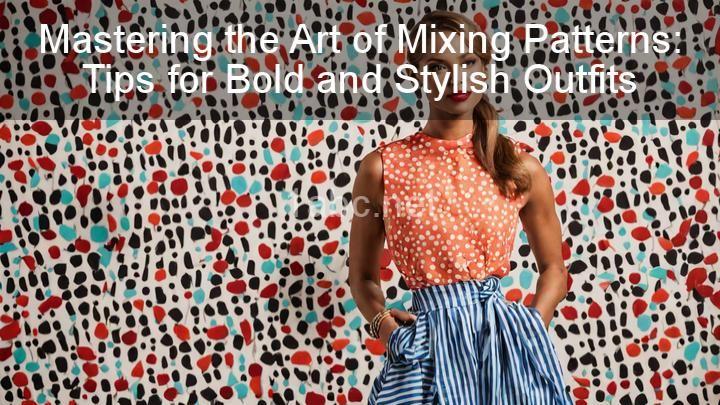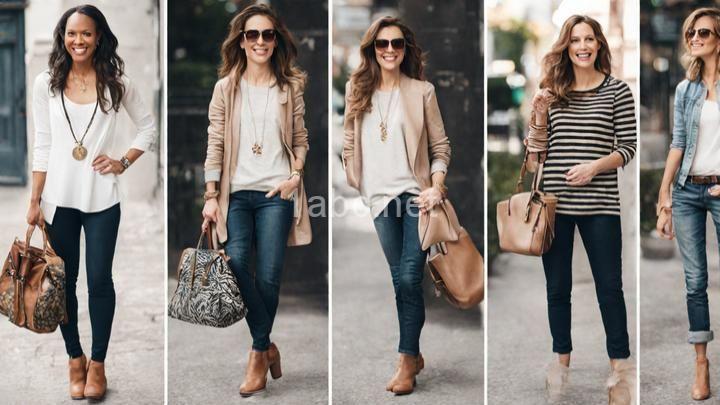Mastering the Art of Mixing Patterns: Tips for Bold and Stylish Outfits

Introduction:
Embrace your inner fashionista and learn how to confidently mix patterns in your outfits! Mixing patterns is an art form that can elevate your style and make a bold fashion statement. By understanding key principles and guidelines, you can master the art of pattern mixing and create unique and stylish outfits that showcase your personal style.
I. Understanding Pattern Types:
To successfully mix patterns, it's important to understand the different pattern types and their characteristics. Stripes, florals, plaids, and animal prints are just a few examples of patterns that can be mixed together. Contrasting or complementary patterns can create visually appealing looks that catch the eye. For example, pairing a striped top with a floral skirt creates an interesting contrast that adds depth and dimension to your outfit. Look for inspiration from fashion magazines and online fashion communities to explore popular pattern combinations and unleash your creativity.
II. Finding Your Color Palette:
Color harmony plays a significant role in pattern mixing. When selecting patterns, it's important to choose a primary color scheme that serves as a cohesive base for your outfit. This can be achieved by selecting patterns that share similar hues or by using a monochromatic color scheme. For example, pairing a navy blue striped blouse with a floral skirt featuring shades of blue creates a cohesive look. To add depth and interest, incorporate accent colors that complement your primary color scheme. This can be done through accessories or by selecting patterns with accents in complementary colors.
III. Scale and Proportion:
Varying the scale of patterns within an outfit is essential for creating balance. Combining large-scale patterns with smaller ones can result in a harmonious look. For example, pairing a bold, large-scale floral print with a subtle, smaller-scale polka dot pattern can create a visually appealing contrast. To break up busy patterns, consider incorporating neutral or solid-colored pieces. This will help create a visual break and ensure that the patterns don't overwhelm the overall look.
IV. Experimenting with Texture:
Texture plays a crucial role in adding dimension to pattern mixing outfits. Incorporating different fabric textures such as silk, tweed, or denim alongside patterns can create a visually interesting and dynamic look. Consider pairing a floral blouse with a tweed skirt or a striped blazer with a denim skirt. When selecting fabrics, be mindful of their weight and drape. A well-balanced ensemble considers the characteristics of each fabric to ensure a cohesive and stylish look.
V. Accessorizing with Confidence:
Accessories can be used strategically to enhance pattern mixing outfits. Statement pieces like belts, scarves, or handbags can tie together various patterns and create a cohesive look. For example, pairing a leopard print belt with a striped top and a plaid skirt can add a touch of sophistication and tie the patterns together. Experiment with different accessories to find what works best with your patterns and personal style. Remember to keep the overall look cohesive by selecting accessories that complement the colors and patterns in your outfit.
VI. Breaking Rules with Style:
While guidelines are helpful, don't be afraid to break the rules to make a bolder fashion statement. Fashion trendsetters often experiment with unconventional pattern combinations and create memorable outfits. For example, mixing floral and animal prints or pairing stripes with polka dots can result in unique and eye-catching looks. Personal style and self-expression are essential in creating outfits that reflect your individuality. Embrace your creativity and experiment with different patterns to discover what truly resonates with you.
Conclusion:
Mastering the art of pattern mixing takes practice and experimentation, but with these guidelines, you can confidently create bold and stylish outfits that showcase your unique style. Remember to understand the characteristics of different pattern types, find your color palette, consider scale and proportion, experiment with texture, and accessorize with confidence. Break the rules when necessary and embrace your personal style. Fashion is all about self-expression, so have fun and create memorable outfits that make you feel confident and stylish. We encourage you to share your own pattern mixing successes in the comments section or on social media platforms. Happy pattern mixing!
FREQUENTLY ASKED QUESTIONS
How do I mix patterns without creating a clashing look?
Mixing patterns can be a fun and stylish way to add interest to your outfits or home decor. Here are a few tips to help you mix patterns without creating a clashing look:
- Start with a cohesive color palette: Choose patterns that share similar or complementary colors. This will help tie them together and create a harmonious look.
- Vary the scale of the patterns: Mix patterns of different sizes to create visual interest. Pair a large-scale pattern with a smaller-scale one to avoid overwhelming the eye.
- Choose a focal point: Determine which pattern will be the main focus and build the rest around it. This will help create a focal point and prevent the patterns from competing with each other.
- Mix patterns with different textures: Combine patterns with different textures to create depth and dimension. For example, pair a smooth, geometric pattern with a textured, organic one to create contrast.
- Use solid colors as anchors: Intersperse solid-colored pieces or accessories between patterns to provide visual breaks and balance out the overall look.
- Balance busy patterns with simpler ones: If you have a bold and busy pattern, pair it with simpler and more subtle patterns to create balance. This will prevent the overall look from becoming overwhelming.
Remember, mixing patterns is all about finding the right balance. Experiment with different combinations, trust your intuition, and have fun with it!
What are some basic rules for combining different patterns in an outfit?
When combining different patterns in an outfit, it's important to follow some basic rules to ensure a cohesive and stylish look. Here are a few guidelines to keep in mind:
- Start with one dominant pattern: Begin by selecting one patterned piece that will be the focal point of your outfit. This can be a bold print or an eye-catching pattern that you want to stand out.
- Stick to a color scheme: To create harmony, choose patterns that share a similar color palette. This will help tie your outfit together and prevent it from looking too chaotic.
- Vary pattern sizes: Mix patterns of different sizes to add visual interest. Pair a large-scale pattern with a smaller-scale one to create a balanced look. This helps prevent the patterns from clashing and overwhelming the overall outfit.
- Contrast patterns: Combining patterns that contrast against each other adds depth and dimension to your outfit. For example, pairing a geometric pattern with a floral one can create a striking visual impact.
- Use neutral pieces as a background: If you're new to mixing patterns, start by incorporating neutral pieces such as solid colors, white, black, or denim. These act as a base and allow the patterns to take center stage without competing with each other.
- Pay attention to texture: Patterns aren't limited to just prints. Incorporating textured fabrics, such as lace, tweed, or knit, can add another level of visual interest to your outfit. Consider mixing a patterned piece with a textured one for a well-rounded look.
Remember, fashion is subjective, and these rules can be broken if you feel confident in your choices. Experimentation is key, so have fun and let your personal style shine through!
Can I mix patterns of different scales, such as large and small prints?
Yes, you can definitely mix patterns of different scales, such as large and small prints. Mixing patterns adds interest and visual depth to your overall look. Here are a few tips to keep in mind when mixing patterns:
- Choose a common color palette: Select patterns that share at least one or two similar colors. This helps create cohesiveness and prevents the overall look from appearing too busy.
- Vary the scale: To create balance, mix patterns of varying scales. For example, pair a large-scale floral print with a small-scale polka dot or a thin striped pattern with a bold geometric design.
- Use a solid anchor: To ground the look and provide a visual break, incorporate solid-colored pieces. This can be in the form of solid-colored clothing items or accessories such as belts or bags.
- Experiment with different textures: Mix patterns with different textures to add depth to your outfit. For example, pair a flowy floral skirt with a structured striped blazer.
Remember, fashion is about personal expression, so feel free to experiment and have fun with your pattern mixing.
Are there any specific patterns that go well together?
Yes, there are many specific patterns that go well together in various contexts. Here are a few examples:
- Stripes and Florals: This combination can create a visually interesting and dynamic look. Pairing a striped top with a floral skirt or vice versa can add a playful and stylish touch to your outfit.
- Polka Dots and Denim: Polka dots are a classic pattern that pairs well with denim. Try wearing a polka dot blouse or dress with your favorite jeans or denim jacket for a cute and timeless look.
- Plaid and Leather: The combination of plaid and leather can create a chic and edgy outfit. Consider pairing a plaid shirt with leather pants or a leather jacket for a cool and fashionable look.
- Geometric and Solid: Mixing geometric patterns with solid colors can create a balanced and modern outfit. For example, pair a geometric patterned skirt with a solid-colored blouse or vice versa for a stylish and eye-catching combination.
Remember, fashion is subjective and personal style plays a big role in determining what patterns go well together. Feel free to experiment and have fun creating your own unique combinations!
